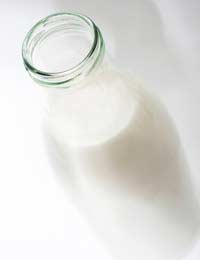Milk Intolerance in Children

Milk intolerance is generally an inability to break down lactose, a sugar found in milk. It is not the same as milk allergy.
Lactose Intolerance
Lactose is the form of sugar found in cows’, goats’ and sheep’s milk, and has to be broken down before it can be absorbed by the gut. People with lactose intolerance do not have enough of the enzyme lactase, which breaks lactose down into glucose and galactose, which can then be absorbed. Gut bacteria then breaks down the lactose that isn’t broken down by lactase, which causes symptoms like diarrhoea, feeling nauseous, bloating, stomach pains and wind.In general, babies naturally have higher levels of lactase than older children and adults.
Lactose intolerance can be diagnosed using breath tests or blood tests in older children, and tests on the stools in younger children and babies.
Lactose intolerance can be inherited, or can be caused by another digestive disease such as coeliac disease, Inflammatory Bowel Disease (IBS), or Crohn’s disease. Lactose intolerance can be temporary, following a stomach upset or chemotherapy, when it is caused by an inflammation of the lining of the stomach. Premature babies can also have a temporary lactase deficiency, which improves as their guts grow.
Overall, around 70% of the world’s population has some level of lactose intolerance. People from Asia, Africa and South America (or who have ancestors there) are more likely to be lactose intolerant to milk than people from Europe.
Lactose intolerance is treated by avoiding or reducing consumption of milk and dairy products. Some people with lactose intolerance can tolerate small to moderate amounts of milk and dairy products, and learn how much they can tolerate, and others can eat cheese, because it is lower in lactose than milk, and yoghurt, perhaps because of the ‘good’ bacteria.
Taking tablets or liquid containing lactase can helps the body break down the lactose in dairy food, and many shops sell lactose-reduced cows’ milk. Milk substitutes such as soya milk, rice milk, coconut milk and oat milk do not contain lactose. There are soya versions of cream, yogurt and cheese as well.
Look out for ‘hidden’ lactose in bread, cakes, biscuits, cereals, instant foods, margarine, processed meat and salad dressings, even soft drinks, and some dairy substitutes. Some medicines contain lactose.
Milk Allergy
Milk intolerance is not the same as milk allergy. Milk intolerance is a digestive disorder, and milk allergy is when the immune system reacts to parts of the milk, often the protein casein, or the whey (the watery part of milk).Milk allergy symptoms can be mild or severe, and include sickness and diarrhoea, stomach pain and bloating, rashes, itching, eczema and sneezing, coughing and problems with breathing.
Around 3-7% of babies less than a year old have a milk allergy, and many grow out of it by the time they are three. Some will remain allergic throughout their lives.
Milk allergy is treated by avoiding the milk and dairy products that the individual reacts to. Babies and children with a whey allergy may be able to drink pasteurised milk; however, this process does not affect the casein in the milk. Babies with a casein allergy may be able to drink highly hydrolysed milk formula. Some babies and children with a milk allergy may be able to drink milk substitutes such as milk, rice milk, coconut milk and oat milk, but are unlikely to be able to tolerate goats’ or sheep’s milk.
Calcium
It is important to make sure that children with lactose intolerance or milk allergy take in enough nutrients, especially calcium – good sources of calcium include dark green leafy vegetables, broccoli, nuts and seeds, fish with soft, edible bones, such as tinned salmon and sardines, and seafood.- Are Nuts Healthy?
- Healthy Eating to Avoid Diabetes
- Eating for Healthy Bones
- Why It's Good to Eat as a Family
- Why is Breakfast Important?
- Drinking Water: Why and How Much?
- The Correct Food Portion Sizes for Kids
- When Your Child is Diagnosed With a Failure To Thrive
- From Breast to Bottle
- When and How to Wean Your Baby
- Bottle Feeding Your Baby
- Breast Feeding Your Baby

Re: Superfoods on a Budget
I just checked out these fantastic tips for buying superfoods on a budget! Eating healthy doesn’t have to be expensive. Can’t wait to try…
Re: Fun Facts: How Many Calories Does a Child Burn?
hi, im eleven yrs. I weigh about 100 lbs and believe I am over the normal weight. I am about 4’10 ft. I…
Re: Fun Facts: How Many Calories Does a Child Burn?
I want to clear this up for everybody worried about their weight, especially at a young age you shouldn’t…
Re: Dealing with a Child that is Always Hungry
I am the great grandmother of an 8 year old that I mostly take care of her mom is around but she totally depends…
Re: Fun Facts: How Many Calories Does a Child Burn?
I’m 11 years old and recently got a smart watch. This isn’t a big question but I can’t find how many…
Re: Dealing with a Child that is Always Hungry
I'm immediately suspicious of an article that suggests cereal as a healthy snack. Cereal (especially cereal…
Re: Fun Facts: How Many Calories Does a Child Burn?
How many calories SHOULD an average twelve year old burn daily???
Re: Fun Facts: How Many Calories Does a Child Burn?
I'm 9 years old and I'm trying to set up a health journal but I don't know how many calories I should…
Re: Fun Facts: How Many Calories Does a Child Burn?
Hiw much calories should an average 10 year old burn a day?
Re: Dealing with a Child that is Always Hungry
I’m 16 and my sister is 11 years old 57 inches and weighs 90 pounds she only drinks like 2 or 3 16 ounce bottles…